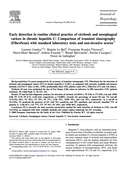Early detection in routine clinical practice of cirrhosis and oesophageal varices in chronic hepatitis C: comparison of transient elastography (FibroScan) with standard laboratory tests and non-invasive scores.
Journal of hepatology
Castéra L, Le Bail B, Roudot-Thoraval F, Bernard PH, Foucher J, Merrouche W, Couzigou P, De Lédinghen V
2009 J. Hepatol. Volume 50 Issue 1
PubMed 19013661 DOI 10.1016/j.jhep.2008.08.018
BACKGROUND/AIMS
To assess prospectively the accuracy of transient elastography (TE, FibroScan) for the detection of cirrhosis and oesophageal varices (OV) in chronic hepatitis C (CHC), as compared with currently available non-invasive methods (AST/ALT ratio (AAR), APRI, prothrombin index (PI), platelet count (PC), FibroTest (FT) and Lok index).
METHODS
All tests were performed the day of liver biopsy (LB), taken as reference, in 298 consecutive CHC patients (cirrhosis: 70; Child-Pugh A: 70; OV: 25).
RESULTS
TE had the best diagnostic accuracy for detection of cirrhosis (AUROCs: TE 0.96 vs. FT 0.82, Lok and APRI 0.80, PC 0.79, PI 0.73, AAR 0.61, respectively; p < 0.0001). Overall, the percentage of saved LB was: TE (cut-off: 12.5 kPa) 90%, PC 82%, FT 79%, PI 77%, AAR 76%, APRI 70%, and Lok 45%, respectively. At a cut-off of 21.5 kPa, TE predicted the presence of OV with 76% sensitivity and 78% specificity and correctly classified 73% of patients vs. AAR 81%, Lok 77%, FT, PI 70%, PC 69%, and APRI 66%, respectively.
CONCLUSIONS
TE is currently the most accurate non-invasive method for early detection of cirrhosis in CHC (cut-off: 12.5 kPa), as compared with other available methods, but cannot replace endoscopy for OV screening.
Citation Reference:

